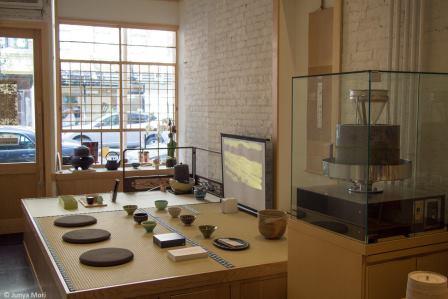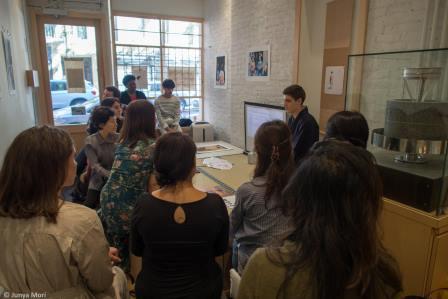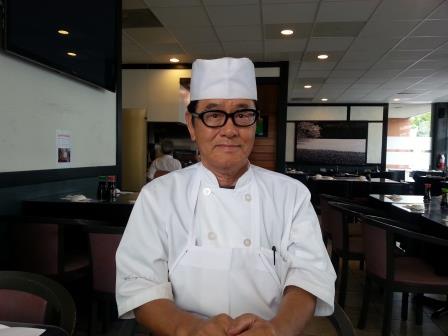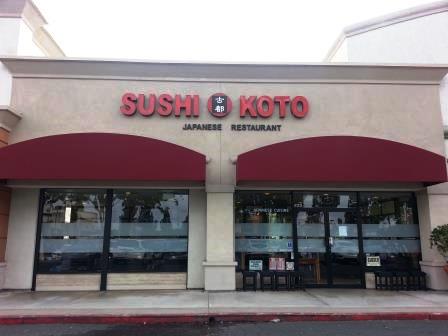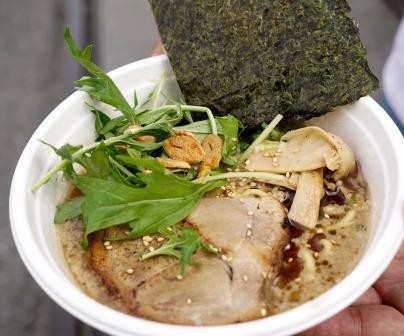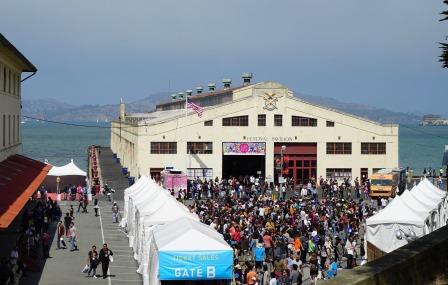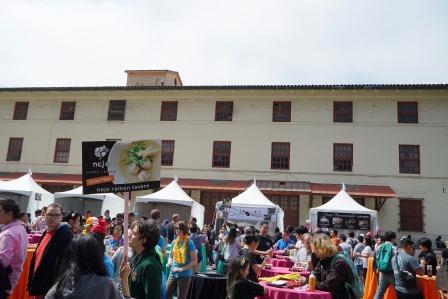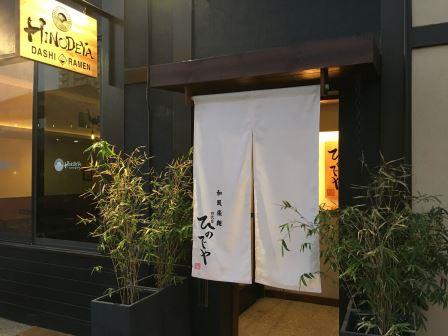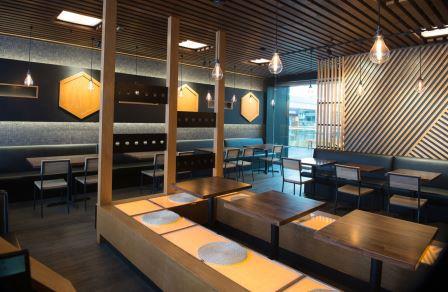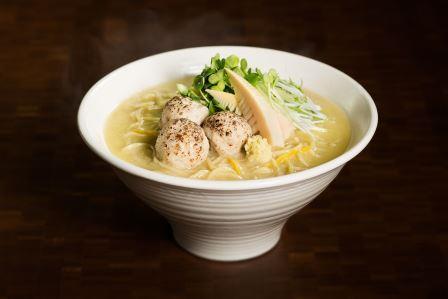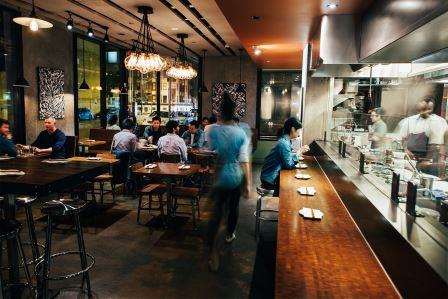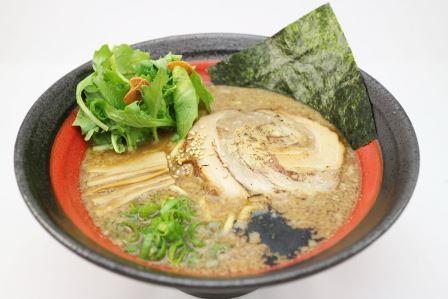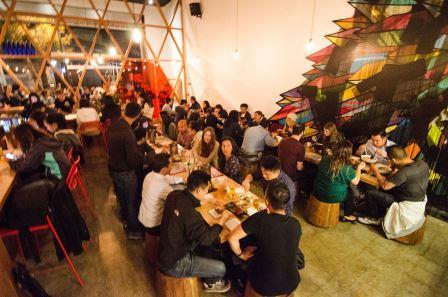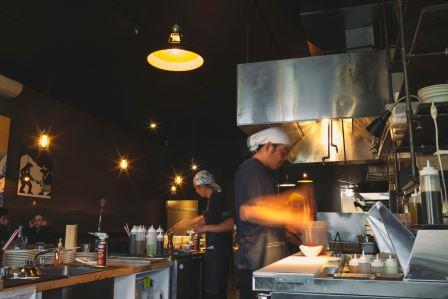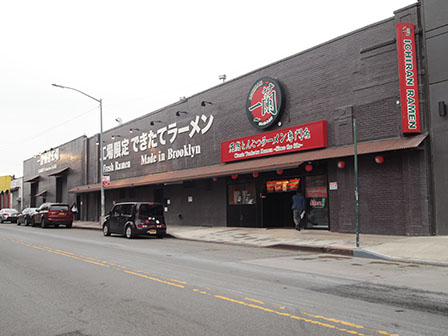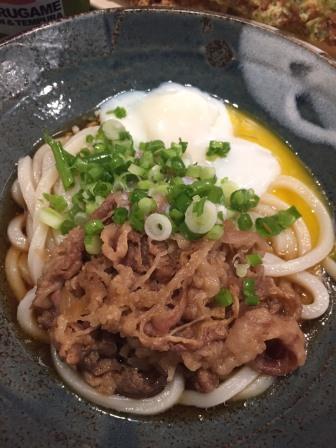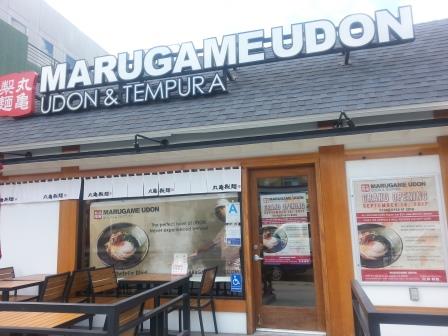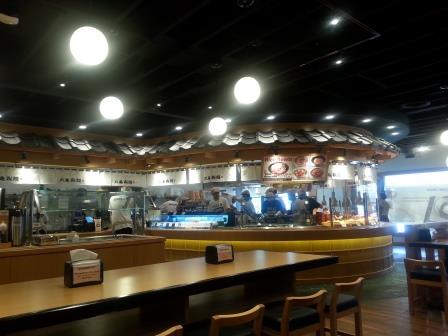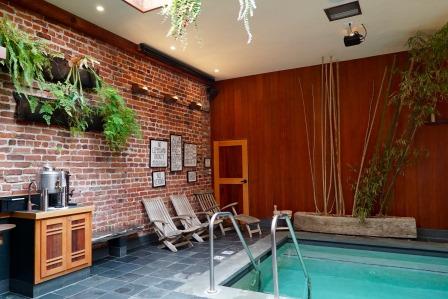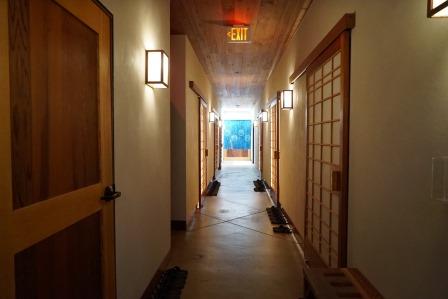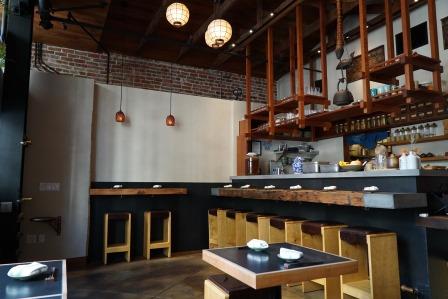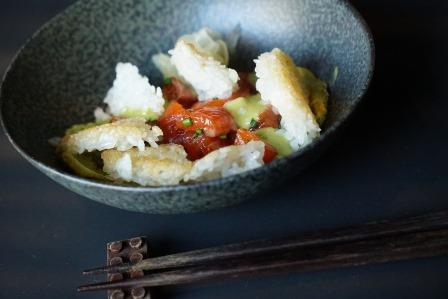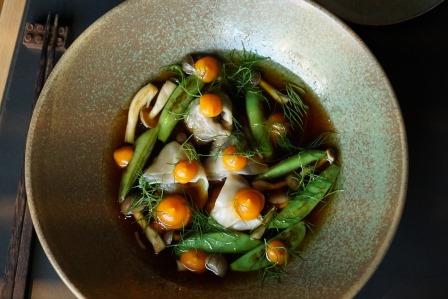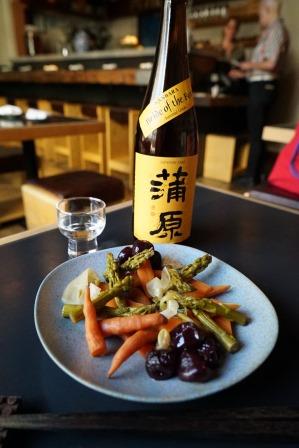Bringing peace of mind to New Yorkers by spreading the practice of Japanese tea ceremony
By Aya Ota
“I need to spread the practice of Japanese Tea Ceremony in New York!” Soheki Mori, tea master, thought intuitively when she visited New York 22 years ago.
“Such a busy city should seek spiritual consolation which the tea ceremony can bring.” Since then, Soheki visited New York every year for 15 years in a row while seriously mastering the tea ceremony in Japan.
In 2011, she moved to the US with her husband, Junya Mori, who is also her business partner. Shortly after their move, the Great East Japan Earthquake occurred, which made them feel even more determined about spreading the practice of Japanese tea ceremony. While they were looking for something to do to support Japan’s disaster areas, the language school they were attending made a suggestion, that was to submit the tea ceremony experience as a charity auction. Since then, they held charity tea ceremony events frequently, and in 2015, they finally found a company to spread such activities more widely. Then, in April of 2017, they opened a long-awaited tea house, “Setsugekka”.
The word, “Setsugekka” in Japanese, consists of 3 Chinese characters, Setsu (snow), Getsu (moon), and Ka (flowers), which expresses Japanese seasonal beauty. As the name suggests, once you step into the shop, the chaos of the East Village vanishes instantly, and you feel as if you stepped into a different world. A space of tatami mats imported from Japan is set up near the entrance, and there is counter space in the back. It is a beautiful and sophisticated looking place.
In order for the customers to fully enjoy matcha, the main item, they offer many ways to serve it. You can choose your favorite type of container (ceramic bowl, paper cup, or glass), temperature (warm, cold, or room temperature), thickness, straight or with milk, etc.
There are 3 different grades of matcha choices too, and overall, there are more than 30 different ways of customization. Soheki makes tea in front of each customer, and gives a detailed explanation as to how to drink it. It is such a special treat to be able to enjoy freshly stone-ground matcha. After trying many different types of milk for “Matcha Latte”, “Matcha-ppuchino”, etc., Soheki adopted non-dairy almond milk as the best match to matcha. The “Matcha Affogato”, which is milk gelato served with thick matcha poured onto it, is one of customers’ favorites. The reason for choosing milk gelato instead of vanilla ice cream was to avoid the vanilla flavor to work against the matcha flavor. The pricing differs depending on the kind of matcha, but is set reasonably to attract more regular customers. For the confectionary to match the matcha drinks, they sell rice flour-based baked items imported from Japanese patisseries in their original packages, and for weekends, they serve Japanese style mochi confectionary made by a patisserie who resides in New York.
While running the tea house, they hold tea ceremony classes and meetings regularly at Setsugekka. The attendees are made up of various genders, ages, nationalities, and occupations. Also, once a month, they hold another type of event or exhibition in collaboration with pottery artists, confectionary artisans, calligraphers, etc. All these added ventures create a synergy effect, and bring in more customers. It is not easy to accumulate customers on weekdays in the East Village, so they use SNS such as Facebook and Instagram, and e-newsletters to advertise. The sales of matcha and tea bowls are doing well, too. Their matcha is all made in Japan. The selection includes organically-grown “Ishikawa” (Ishikawa Seicha/Toyota, Aichi), “Hosinotsuyu”, “Seiju” (Hoshino-Seichaen /Yame, Fukuoka), “Joubetsugi”, “Senjunomukashi” (Honey&Sons), “PANATEA”. Mr. and Mrs. Mori visited all the producers, and carefully selected these matcha, checking not only the taste, but also learning the background of each tea manufacturer.
They also visited creators of tea ceremony bowls and utensils, and hand-selected authentic and high-quality items.
They are already so busy handling such a wide variety of businesses by themselves, but there are still a lot more activities that they want to materialize.
They often get requests for lectures and demonstrations from universities and community colleges, and want to do more workshops to familiarize matcha in the everyday lives of people in the community. They also want to open a shop in the Midtown district to achieve their original goal of providing peace of mind to busy people. Furthermore, they are also looking passionately into the future for expanding the business to the West Coast, Paris, and Japan.
茶道を広めニューヨークに安らぎをもたらす
「ニューヨークで茶道を広めたい」——茶道家の森宗碧氏が直感的にそう感じたのは、今から22年前にニューヨークを訪れたときのことだった。「多忙な街だからこそ、茶道がもたらす精神的な安らぎが求められているのではないか」——以来、宗碧氏は本格的に茶道を学ぶ傍ら、15年間連続でニューヨークを訪れた。そして2011年、ビジネスパートナーでもある夫の森絢也氏と共に渡米。その直後に、東日本大震災が発生したことが、「茶道を広めたい」という二人の想いをさらに強くする運命的な出来事になったのだろう。「日本のために何かしたい」と考えていたところ、当時通学していた語学学校から「茶道体験をチャリティーオークションとして出品してはどうか」と提案があった。それをきっかけに頻繁にチャリティー茶会を行うようになり、2015年には活動の幅を広げるべく会社を設立。そして2017年4月、満を持してティーハウス『雪月華』開店に至った。
『雪月華』とは、漢字では雪・月・華の三文字で構成され、日本の美しい季節の風景を表現する言葉。その名の通り、店内に足を踏み入れると、イーストヴィレッジの喧騒が一瞬にして静まり、まるで別世界に入り込んだような錯覚を覚える。手前には日本から取り寄せた畳の座敷、奥にはカウンター席が配置され、美しく洗練された空間だ。
主役である抹茶を存分に楽しんでもらうために、提供方法は細かく分類されている。容器(茶碗・カップ・グラス)、好みの温度(温・冷・常温)、抹茶の濃さ、ストレートなのかミルクを加えるのか…。さらに抹茶を常時3種類から選ぶことができ、実に30種類以上ものカスタマイズができる仕組みだ。一人一人の客に対し丁寧に飲み方を説明し、宗碧氏が目の前で一杯ずつ入れてくれる。店内に設置された石臼で碾き立ての抹茶を楽しめるのも格別の体験だ。「抹茶ラテ)」や「抹茶プチーノ」には、さまざまなミルクを試した結果、抹茶との相性を考え、植物性のアーモンドミルクを採用した。濃茶をミルク・ジェラートにかける「抹茶アフォガート」は人気メニューのひとつ。バニラ・アイスクリームではなく、ミルク・ジェラートを選んだのは、バニラの香りが抹茶の風味を妨げるという理由からだ。価格は、抹茶の種類によって異なるが「定期的に来てほしい」という考えから、リーズナブルに設定している。抹茶に合わせる菓子は、日本のパティスリーより取り寄せた米粉の焼き菓子をオリジナルのパッケージで販売しているほか、週末には ニューヨーク在住のパティシエが作るお餅を使った和菓子を提供している。
ティーハウス運営の傍ら、茶道稽古や茶会も同場所で定期的に開催。参加者は老若男女、人種も職業もさまざまだ。また、月1回の頻度で、陶芸家や菓子職人、書道家らとコラボレーションしてイベントや展示会も実施している。これらすべての事業が相乗効果を生み、集客に好循環をもたらしているという。イーストヴィレッジという立地上、平日の集客は簡単ではないが、フェイスブックやインスタグラムなどのSNSやEニュースレターを活用している。抹茶や茶器などの物販も好調だ。抹茶はすべて日本産で、有機栽培抹茶「いしかわ」(いしかわ製茶、愛知県豊田市)、「星の露」「星授」(星野製茶園、福岡県八女市)、「上別儀」「千寿の昔」(Honey&Sons)、「PANATEA」など複数用意。どれも、夫婦で生産者を訪問し、味はもちろんのこと、背景やストーリーもよく知った上で厳選した。茶碗や茶杓など茶器も、夫婦で作家や職人を訪ね、本格的で高品質なものを揃えている。
これだけ多岐にわたる事業を夫婦二人でこなしているので多忙だが、まだまだ実現させたい活動が山積しているという。大学やコミュニティカレッジからも講義や実演の依頼も多く、抹茶を身近に感じてもらえるようなワークショップも増やしたいと考えている。また、「忙しい人にこそ安らぎを提供したい」という当初の目的を達成するべく、ミッドタウン地区へ出店したいという展望もある。将来は、西海岸、パリ、日本への展開も視野に入れ、情熱を燃やす日々だ。
Setsugekka East Village
74 E 7th Street
New York, NY 10003
Tel: 646-895-9586
https://www.setsugekkany.com/
Mon, Wed – Fri 10:30am - 6pm
Sat, Sun 10:30am - 7pm
Tuesday Closed
*Changes depending on the tea ceremony class or the event
“I need to spread the practice of Japanese Tea Ceremony in New York!” Soheki Mori, tea master, thought intuitively when she visited New York 22 years ago.
“Such a busy city should seek spiritual consolation which the tea ceremony can bring.” Since then, Soheki visited New York every year for 15 years in a row while seriously mastering the tea ceremony in Japan.
In 2011, she moved to the US with her husband, Junya Mori, who is also her business partner. Shortly after their move, the Great East Japan Earthquake occurred, which made them feel even more determined about spreading the practice of Japanese tea ceremony. While they were looking for something to do to support Japan’s disaster areas, the language school they were attending made a suggestion, that was to submit the tea ceremony experience as a charity auction. Since then, they held charity tea ceremony events frequently, and in 2015, they finally found a company to spread such activities more widely. Then, in April of 2017, they opened a long-awaited tea house, “Setsugekka”.
The word, “Setsugekka” in Japanese, consists of 3 Chinese characters, Setsu (snow), Getsu (moon), and Ka (flowers), which expresses Japanese seasonal beauty. As the name suggests, once you step into the shop, the chaos of the East Village vanishes instantly, and you feel as if you stepped into a different world. A space of tatami mats imported from Japan is set up near the entrance, and there is counter space in the back. It is a beautiful and sophisticated looking place.
In order for the customers to fully enjoy matcha, the main item, they offer many ways to serve it. You can choose your favorite type of container (ceramic bowl, paper cup, or glass), temperature (warm, cold, or room temperature), thickness, straight or with milk, etc.
There are 3 different grades of matcha choices too, and overall, there are more than 30 different ways of customization. Soheki makes tea in front of each customer, and gives a detailed explanation as to how to drink it. It is such a special treat to be able to enjoy freshly stone-ground matcha. After trying many different types of milk for “Matcha Latte”, “Matcha-ppuchino”, etc., Soheki adopted non-dairy almond milk as the best match to matcha. The “Matcha Affogato”, which is milk gelato served with thick matcha poured onto it, is one of customers’ favorites. The reason for choosing milk gelato instead of vanilla ice cream was to avoid the vanilla flavor to work against the matcha flavor. The pricing differs depending on the kind of matcha, but is set reasonably to attract more regular customers. For the confectionary to match the matcha drinks, they sell rice flour-based baked items imported from Japanese patisseries in their original packages, and for weekends, they serve Japanese style mochi confectionary made by a patisserie who resides in New York.
While running the tea house, they hold tea ceremony classes and meetings regularly at Setsugekka. The attendees are made up of various genders, ages, nationalities, and occupations. Also, once a month, they hold another type of event or exhibition in collaboration with pottery artists, confectionary artisans, calligraphers, etc. All these added ventures create a synergy effect, and bring in more customers. It is not easy to accumulate customers on weekdays in the East Village, so they use SNS such as Facebook and Instagram, and e-newsletters to advertise. The sales of matcha and tea bowls are doing well, too. Their matcha is all made in Japan. The selection includes organically-grown “Ishikawa” (Ishikawa Seicha/Toyota, Aichi), “Hosinotsuyu”, “Seiju” (Hoshino-Seichaen /Yame, Fukuoka), “Joubetsugi”, “Senjunomukashi” (Honey&Sons), “PANATEA”. Mr. and Mrs. Mori visited all the producers, and carefully selected these matcha, checking not only the taste, but also learning the background of each tea manufacturer.
They also visited creators of tea ceremony bowls and utensils, and hand-selected authentic and high-quality items.
They are already so busy handling such a wide variety of businesses by themselves, but there are still a lot more activities that they want to materialize.
They often get requests for lectures and demonstrations from universities and community colleges, and want to do more workshops to familiarize matcha in the everyday lives of people in the community. They also want to open a shop in the Midtown district to achieve their original goal of providing peace of mind to busy people. Furthermore, they are also looking passionately into the future for expanding the business to the West Coast, Paris, and Japan.
茶道を広めニューヨークに安らぎをもたらす
「ニューヨークで茶道を広めたい」——茶道家の森宗碧氏が直感的にそう感じたのは、今から22年前にニューヨークを訪れたときのことだった。「多忙な街だからこそ、茶道がもたらす精神的な安らぎが求められているのではないか」——以来、宗碧氏は本格的に茶道を学ぶ傍ら、15年間連続でニューヨークを訪れた。そして2011年、ビジネスパートナーでもある夫の森絢也氏と共に渡米。その直後に、東日本大震災が発生したことが、「茶道を広めたい」という二人の想いをさらに強くする運命的な出来事になったのだろう。「日本のために何かしたい」と考えていたところ、当時通学していた語学学校から「茶道体験をチャリティーオークションとして出品してはどうか」と提案があった。それをきっかけに頻繁にチャリティー茶会を行うようになり、2015年には活動の幅を広げるべく会社を設立。そして2017年4月、満を持してティーハウス『雪月華』開店に至った。
『雪月華』とは、漢字では雪・月・華の三文字で構成され、日本の美しい季節の風景を表現する言葉。その名の通り、店内に足を踏み入れると、イーストヴィレッジの喧騒が一瞬にして静まり、まるで別世界に入り込んだような錯覚を覚える。手前には日本から取り寄せた畳の座敷、奥にはカウンター席が配置され、美しく洗練された空間だ。
主役である抹茶を存分に楽しんでもらうために、提供方法は細かく分類されている。容器(茶碗・カップ・グラス)、好みの温度(温・冷・常温)、抹茶の濃さ、ストレートなのかミルクを加えるのか…。さらに抹茶を常時3種類から選ぶことができ、実に30種類以上ものカスタマイズができる仕組みだ。一人一人の客に対し丁寧に飲み方を説明し、宗碧氏が目の前で一杯ずつ入れてくれる。店内に設置された石臼で碾き立ての抹茶を楽しめるのも格別の体験だ。「抹茶ラテ)」や「抹茶プチーノ」には、さまざまなミルクを試した結果、抹茶との相性を考え、植物性のアーモンドミルクを採用した。濃茶をミルク・ジェラートにかける「抹茶アフォガート」は人気メニューのひとつ。バニラ・アイスクリームではなく、ミルク・ジェラートを選んだのは、バニラの香りが抹茶の風味を妨げるという理由からだ。価格は、抹茶の種類によって異なるが「定期的に来てほしい」という考えから、リーズナブルに設定している。抹茶に合わせる菓子は、日本のパティスリーより取り寄せた米粉の焼き菓子をオリジナルのパッケージで販売しているほか、週末には ニューヨーク在住のパティシエが作るお餅を使った和菓子を提供している。
ティーハウス運営の傍ら、茶道稽古や茶会も同場所で定期的に開催。参加者は老若男女、人種も職業もさまざまだ。また、月1回の頻度で、陶芸家や菓子職人、書道家らとコラボレーションしてイベントや展示会も実施している。これらすべての事業が相乗効果を生み、集客に好循環をもたらしているという。イーストヴィレッジという立地上、平日の集客は簡単ではないが、フェイスブックやインスタグラムなどのSNSやEニュースレターを活用している。抹茶や茶器などの物販も好調だ。抹茶はすべて日本産で、有機栽培抹茶「いしかわ」(いしかわ製茶、愛知県豊田市)、「星の露」「星授」(星野製茶園、福岡県八女市)、「上別儀」「千寿の昔」(Honey&Sons)、「PANATEA」など複数用意。どれも、夫婦で生産者を訪問し、味はもちろんのこと、背景やストーリーもよく知った上で厳選した。茶碗や茶杓など茶器も、夫婦で作家や職人を訪ね、本格的で高品質なものを揃えている。
これだけ多岐にわたる事業を夫婦二人でこなしているので多忙だが、まだまだ実現させたい活動が山積しているという。大学やコミュニティカレッジからも講義や実演の依頼も多く、抹茶を身近に感じてもらえるようなワークショップも増やしたいと考えている。また、「忙しい人にこそ安らぎを提供したい」という当初の目的を達成するべく、ミッドタウン地区へ出店したいという展望もある。将来は、西海岸、パリ、日本への展開も視野に入れ、情熱を燃やす日々だ。
Setsugekka East Village
74 E 7th Street
New York, NY 10003
Tel: 646-895-9586
https://www.setsugekkany.com/
Mon, Wed – Fri 10:30am - 6pm
Sat, Sun 10:30am - 7pm
Tuesday Closed
*Changes depending on the tea ceremony class or the event







